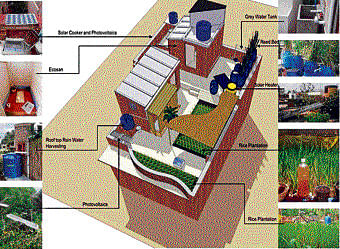A smart roof is where the simple RCC slab over our head is turned into a veritable ecological space. Chitra Vishwanath writes about smart use of roofs, drawing from her own experience of raising paddy on her roof.
It is estimated that about 50 per cent of built Bangalore is roofs. Most of these are non-designed terraces virtually sterile i.e. devoid of any kind of biological activity. Besides they are also heat sinks; since being of RCC they absorb heat during the hotter period of time and radiate back inside during the night.
The City is also constantly expanding. The City expands into the hinterland turning it into inorganic spaces. The City does not consume these adjoining lands only for habitation but also for making products for building-like agriculture land is dug up for making bricks, or is an yard for making concrete blocks. This very active land is replaced with as mentioned earlier a sterile space which while being an inactive space also contributes to the urban heat island effect.
Roofs receive vast amounts of sun’s light and heat, wind and rain, and once designed well, they can foster amazing amount of biodiversity while being an active player in solving many of the crisis- of water, energy, waste disposal and, food and lack of sparrows.
Such designed roofs we call SMART roofs. Smart in a mnemonic sense means that a project is achievable and affordable. Each of the letters signify the following: S- Simple, M-measurable, A-Achievable, R-relevant, T-timely and tangible. Thus a smart roof is where the simple RCC slab over our head is turned into a veritable ecological space.
Bangalore receives an average of 970 mm of rainfall annually. A family of five needs about 750 litres of water every day. Through rainwater harvesting, house with 100 sqm of roof area can harvest about lakhs of litres of water every year, approximately enough for about 135 days in a year.
To transport this water either from the Cauvery or from our borewells, a large amount of energy is expended. This energy comes to us from at least 100 km and with the water running low, we all are aware that soon we will have massive power cuts. If only water is stored where it falls close to use, the energy required for its use can be reduced. The smart roof will have solar installations for water heating as well as for generating electricity and for cooking. Therefore, these roofs also are part of energy generation capability of a household and making the homes sustainable part of a larger human community.
The roofs are heat sinks as mentioned earlier and construction takes away the agricultural and bio-diversity spaces. The terraces thus should be turned into agricultural lands.
By incorporating an Ecosan toilet, the human waste is turned into a resource. By treating the grey water emanating from the showers and washing machines on the rooftop treated water is made available for gardening and flushing, thereby reducing further the daily fresh water demand.
The daily water demand for gardening and flushing is close to 30 litres . When water is recycled, the water harvested would last for 30 more days.
This treated water is a lot more than what is needed for flushing. The ph content along with soap’s phosphates makes the water conducive to have a rice field on our terraces. This rice field cools the terrace lowering the internal room temperature by at least 60C. The rice field is fertilised from the hygienised human waste generated in the Ecosan toilet, thus turning the roof into a space which also takes care of the waste in one’s own living space rather than polluting somebody else’s faraway.
Reverting to being SMART, all of these are simple, measurable, achievable, relevant and tangible activities which can happen on our otherwise sterile energy guzzling, heat generating sterile roofs.
